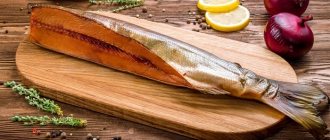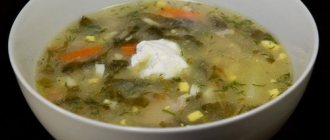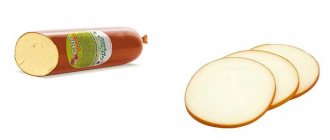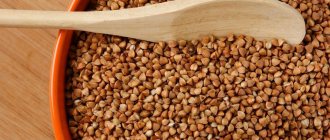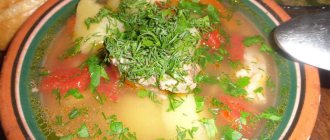Nutritional value and composition
Champignon is 80% water.
Another 20% are vitamins, organic acids and minerals. Table 1 “Chemical composition of champignons”
| Compound | Contents per 100 grams |
| Squirrels | 4.3 g |
| Carbohydrates | 0.1 g |
| Fats | 1 g |
| Water | 81 g |
| Ash | 1 g |
| Alimentary fiber | 2.6 g |
| Unsaturated fatty acids | 0.1 g |
| Saturated fatty acids | 0.1 g |
| Mono- and disaccharides | 0.1 g |
| Vitamins | |
| Vitamin A | 2 mcg |
| Beta carotene | 0.01 mg |
| Thiamine (vitamin B1) | 0.1 mg |
| Riboflavin (vitamin B2) | 0.45 mg |
| Pyridoxine (vitamin B6) | 0.05 mg |
| Pantothenic acid (vitamin B5) | 2.1 mg |
| Folic acid (vitamin B9) | 30 mcg |
| Vitamin PP | 5.6 mg |
| Vitamin E | 0.1 mg |
| Vitamin C | 7 mg |
| Minerals | |
| Calcium | 4 mg |
| Potassium | 530 mg |
| Sodium | 6 mg |
| Phosphorus | 115 mg |
| Sodium | 6 mg |
| Chlorine | 25 mg |
| Fluorine | 14 mcg |
| Iron | 0.3 mg |
| Iodine | 18 mcg |
| Zinc | 0.28 mg |
| Chromium | 13 mcg |
| Cobalt | 15 mcg |
| Molybdenum | 3 mcg |
| Rubidium | 26 mcg |
As you know, all mushrooms are rich in proteins. And champignons are no exception: 1 kilogram of this product contains approximately as much protein as 1 liter of cow's milk. Pecheritsa protein contains 18 amino acids, 8 of which are essential (they enter the human body exclusively with food and cannot be synthesized). Japanese researchers have found that champignons contain high amounts of amino acids such as lysine and arginine, which have a beneficial effect on the development of human mental abilities and memory. The protein of this mushroom is absorbed by 70-80%. Therefore, those who consume them can, without harming their health, give up sausages and meat.
Champignons are similar in phosphorus content to fish. Their chemical composition is quite large, and this distinguishes these mushrooms from others. They harmoniously combine vitamins, beneficial macro- and microelements. The caloric content is very low - 100 grams contain no more than 27 kcal.
Harm and contraindications to eating champignons
Excessive consumption of champignons is fraught with undesirable consequences. The product tends to absorb harmful substances from the environment. When eating mushrooms collected in places with unfavorable ecology, the risk of poisoning increases.
Contraindications to use of the product are as follows:
- liver diseases;
- allergic reaction to vegetable protein;
- age up to 12 years;
- individual intolerance.
Mushrooms are a heavy food that is difficult to digest due to the chitin contained in the product. For this reason, you should not overuse champignons, otherwise gastrointestinal diseases may develop.
© Nickola_Che — stock.adobe.com
A little history
The champignon is one of the first cultivated mushrooms. We owe its wide distribution primarily to the King of France, Louis XIV (1638-1715). He was a connoisseur of mushroom dishes and ordered his gardeners to “domesticate” meadow champignons. At first they were grown on lawns as seed, using mycelium that was collected in nature, and then collected from their beds.
At the end of the 17th century, it was noticed that pecheritsa could grow well in underground rooms and basements. Their cultivation in France reached its maximum development in the 18th-19th centuries, especially near Paris. This was facilitated by the presence of old quarries, in which throughout the year the temperature was in the range of 12-14 ° C, favorable for the cultivation of these mushrooms. Champignon culture from France penetrated into Germany, Great Britain and other European countries. Since 1903, they began to be grown in America.
In 1893-1894 in France, the Pasteur Institute developed a method for germinating champignon spores and obtaining sterile mycelium. In most countries where the culture of these mushrooms had already spread, by 1924 special laboratories had been developed where their sterile mycelium was produced. In Russia, champignons began to be bred starting in the middle of the 18th century.
Today, champignons are cultivated in more than 70 countries around the world. This industry is most developed in the UK, USA, Germany, France, Denmark, the Netherlands and other countries. About 25% of production occurs in the United States, which is also the main exporter of such mushrooms.
The largest plantation in the world is located in an old limestone mine in Pennsylvania. The underground galleries of the plantation are 24 kilometers long.
Mushrooms. Calorie table and chemical composition of food
Page 2
Energy value, or calorie content
- this is the amount of energy released in the human body from food during the digestion process. The energy value of the product is measured in kilocalories (kcal) or kilojoules (kJ) per 100 grams. product.
The kilocalorie used to measure the energy value of food is also called a food calorie, so when caloric content is reported in (kilo)calories, the prefix kilo is often omitted.
You can see detailed energy value tables for Russian products here.
The nutritional value
— content of carbohydrates, fats and proteins in the product.
Nutritional value of food product
- a set of properties of a food product, in the presence of which the physiological needs of a person for the necessary substances and energy are satisfied.
Vitamins
, organic substances required in small quantities in the diet of both humans and most vertebrates. Vitamin synthesis is usually carried out by plants, not animals.
A person's daily requirement for vitamins is only a few milligrams or micrograms. Unlike inorganic substances, vitamins are destroyed by strong heat.
Many vitamins are unstable and are 'lost' during cooking or food processing.
Page 3
Energy value, or calorie content
- this is the amount of energy released in the human body from food during the digestion process. The energy value of the product is measured in kilocalories (kcal) or kilojoules (kJ) per 100 grams. product.
The kilocalorie used to measure the energy value of food is also called a food calorie, so when caloric content is reported in (kilo)calories, the prefix kilo is often omitted.
You can see detailed energy value tables for Russian products here.
The nutritional value
— content of carbohydrates, fats and proteins in the product.
Nutritional value of food product
- a set of properties of a food product, in the presence of which the physiological needs of a person for the necessary substances and energy are satisfied.
Vitamins
, organic substances required in small quantities in the diet of both humans and most vertebrates. Vitamin synthesis is usually carried out by plants, not animals.
A person's daily requirement for vitamins is only a few milligrams or micrograms. Unlike inorganic substances, vitamins are destroyed by strong heat.
Many vitamins are unstable and are 'lost' during cooking or food processing.
Cultivation of champignons
The reason for the widespread production of champignons is their abundant fruiting, excellent taste and unpretentiousness. In terms of their nutritional properties, cultivated pecheritsa are similar to wild ones, but their value is much higher. They can be grown all year round. Champignons bear fruit well in the dark due to the lack of chlorophyll in their tissues. Nowadays, the production technologies of these mushrooms have almost reached absolute automation. They are grown in specially equipped basements, greenhouses, and open ground. Champignons grown artificially are not capable of polluting the external environment. Modern technologies make it possible to prevent the penetration of toxic substances, bacteria, and protein breakdown products into the mycelium.
To summarize
Now you know about the benefits and harms of champignons, as well as the basic rules for eating dishes with this ingredient. In fact, if you cook fresh mushrooms correctly and tasty, the beneficial properties will completely dominate, while the negative qualities will practically not manifest themselves. Chitin causes the greatest harm to the human body, but it is produced in large quantities only a few days after the fungus detaches from the mycorrhiza.
Therefore, if you picked mushrooms in the morning or at lunch, and in the evening or the next morning you already cooked or pickled them, then you are definitely in no danger (provided that you carefully checked the champignons for the absence of worms and did not accidentally pick a non-edible mushroom). It is for this reason that you should always take an experienced mushroom picker with you on a mushroom picking trip in the forest, if you are not one. Write your questions regarding the topic of this article in the comments. Well, share your opinion on how exactly you like to cook champignons: stew, boil, steam, fry or bake. It will be very interesting to read. Bon appetit and see you soon!
Purchase and selection
Fresh champignons can be purchased in stores and markets. When choosing, you need to pay attention to the following criteria:
- fresh mushrooms are white, sometimes with a pinkish or beige tint;
- matte surface of the cap;
- absence of dents, dark areas or stains on the surface;
- the damaged integrity of the film connecting the stem and cap indicates the “old age” of the mushroom;
- smell the mushroom - its freshness is indicated by a pronounced pleasant smell that resembles anise;
- fresh champignon is elastic to the touch, but spoiled one is like a sponge.
How many calories are in baked champignons?
One of the most popular hot appetizers, usually served with cheese. It melts in the oven and forms a tender crust that complements the taste of the mushrooms. You can also experiment with different minced meats and fill the cap, for example, with finely chopped pieces of meat and a mushroom leg. It is better to mix the filling with sour cream or mayonnaise so that it remains juicy and does not dry out during cooking. And yet, how many calories are in baked champignons in the oven? – 135 kcal per 100 g, but sometimes you can treat yourself to something tasty!
Storage conditions
Let's consider different options for storing champignons.
- Opened mushrooms can be stored in the refrigerator for up to 2-3 days - not covered with film, they become airy and begin to darken. Under cling film, the shelf life is extended to 5-6 days. If stored for a longer period of time, they can harm the body.
- To increase shelf life, champignons are frozen. In this form they can be stored for a very long time, but defrost them in portions - they should not be allowed to re-freeze. To freeze fresh mushrooms, you need to wash them well, dry them, and if necessary, cut large ones into pieces and trim off the excess. After this, freezing is carried out. Store them in tightly tied bags.
- You can freeze pre-fried champignons. To do this, add oil to a deep frying pan and fry until the moisture evaporates or put it in the oven without oil. Then the fried mushrooms are placed in a container and frozen. They can be stored in this form for no more than 6 months.
- The champignons are washed and boiled in lightly salted water, cooled, dried thoroughly, placed on foil or a baking sheet in one layer and frozen. Shelf life - no more than six months in tied portion bags.
How many calories are in boiled champignons?
In their pure form, boiled mushrooms have not gained such popularity as, for example, baked or fried mushrooms, but they can be added to salads and other snacks. They cook in just 10-15 minutes, so you don’t have to stand at the stove for a long time. Well, how can we not mention mushroom soups that have such a delicate taste? Such a dish will not only be a lifesaver during fasting, but also for those who are on a proper diet - it is healthy and will not harm your figure at all - only 24 calories per 100 grams!
Use in cooking
Champignons are widely used for preparing a variety of dishes, pickled, dried, frozen or fried. They are baked in clay pots, added to salads, soups, snacks, baked goods (as a filling for pizzas, sandwiches, zraz, pies), stewed in sour cream or various sauces. Young mushrooms are often eaten because they have the most delicate taste. In cooking, more than 200 dishes can be prepared from them.
Champignons go well with vegetables, seafood and fish, meat, cereals, eggs, and cheese. Many people like stewed potatoes with champignons, but, according to nutritionists, mushrooms and potatoes do not go well together, just like with nuts and milk: dissimilar proteins, high glycemic index of starch - as a result, digestive upset is possible.
Before cooking, the mushroom must be cleaned of soil and other contaminants. First, use a knife to clean off the dirt and quickly rinse the champignons under running water. It is not recommended to leave them in water for a long time, otherwise the mushrooms will become tasteless and watery. When cleaning, the film that is located between the cap and the stem is removed. The bottom of the leg is cut off if it is dirty.
Although champignons can be eaten fresh, in most cases they are eaten after short-term heat treatment. Champignons that are grown industrially are more widely used because they tolerate any type of cooking well. Wild ones are well suited for fillings, sauces, and first courses. But they are not suitable for frying - they will become very hard and dry.
How many calories are in grilled champignons?
With the onset of spring, when the time begins for barbecues and trips somewhere into nature, in addition to traditional grilled meat, it is impossible to do without grilled champignons - this is one of the healthiest ways to cook them! Mushrooms can be pre-marinated in soy sauce or baked in their pure form. But it is known that mushrooms quickly lose moisture, so we still recommend lubricating them a little with oil, which will prevent them from drying out and make them incredibly tender. The smell of smoke combined with creamy garlic sauce is a wonderful side dish or an independent dish, and 100 grams contains only 35 calories!
Medicinal properties
Champignons have medicinal properties. They have found their application in folk medicine and dietetics.
- The low calorie content of champignons allows them to be used in various diets for weight loss, without depriving yourself of essential vitamins and other beneficial substances. Due to its low sodium content, it is successfully used in salt-free diets.
- Such mushrooms can be eaten by diabetics - they contain no sugar and virtually no fat.
- Champignons have the ability to cleanse the body by removing heavy metal salts.
- They contain aromatic and flavoring extractive substances, which in the body cause the release of digestive juices in abundant quantities, improve the absorption of food and stimulate appetite, and enhance metabolism.
- Due to its expectorant and bronchodilator effect, it can be used for the complex treatment of bronchopulmonary pathology (bronchial asthma, bronchitis, etc.).
- Can lower cholesterol levels and prevent the formation of plaques. Studies have shown that people who often consume these mushrooms have 34% lower blood cholesterol levels compared to those who do not eat champignons. Therefore, the risk of heart attack and atherosclerosis is reduced.
- Due to the high content of riboflavin and thiamine, the use of pecheritsa helps prevent headaches and migraines.
- Helps get rid of psoriasis, eczema, ulcers, purulent skin lesions.
- Slows down skin aging - can be used to make masks.
- The healing properties are also preserved in dried mushrooms. They should be consumed by those people who suffer from stomach ulcers and hepatitis.
How many calories are in stewed champignons?
It can rightfully be considered the most popular cooking method. It is unlikely that you will meet a person who has never tried these mushrooms in this method of processing, because you can stew them with onions, in cream, in sour cream, in butter or vegetable oil, and depending on how you decide to cook them, it will be Calorie content also depends. On average, this dish contains about 54 kcal per 100 grams. If you want to treat yourself to spaghetti with mushrooms in sour cream sauce, but don’t know how many calories there are in champignons stewed in sour cream, then there are no more calories than in fried mushrooms - 42 kcal per 100 grams! To make the champignons successful, it is better to add a tablespoon of flour (to thicken the sauce), a little garlic and dill - these two ingredients will help reveal the taste of the mushrooms in a new range. Stewed champignons can be served either cold or hot.
Contraindications
Despite the usefulness of champignons, there are contraindications to their use:
- It is not recommended for consumption by patients with chronic kidney and digestive diseases.
- The high content of folic acid in mushrooms promotes the growth of malignant cells and their reproduction, so cancer patients should not eat champignons.
- You need to be careful with such mushrooms when breastfeeding and pregnancy.
- Children under 5 years old should not eat any dishes with champignons, even if it is only, for example, a topping on pizza or pies, since their bodies do not have enough enzymes necessary for their digestion.
Champignon is an amazing mushroom that is rich in vitamins and minerals. It is not only an excellent nutritious product, but also has many beneficial properties, thanks to which it is widely used in cosmetology, dietetics and folk medicine.
More fresh and relevant information about health on our Telegram channel. Subscribe: https://t.me/foodandhealthru
We will be grateful if you use the buttons:
How many calories are in steamed champignons?
This cooking method is the least popular, which is completely in vain! After all, this is the most useful method, preserving the greatest amount of nutrients in the product and containing only 27 kcal per 100 g - the same as in fresh mushrooms! The taste of steamed champignons is in no way inferior to other processing methods, and you don’t necessarily need a steamer to prepare it - a slow cooker will do just fine. 10-15 minutes and you will get healthy and tasty food!
Bon appetit!
Calories, kcal:
Proteins, g:
Carbohydrates, g:
Champignons are mushrooms of the Lamellar
, the most common representatives of the mushroom fraternity. Champignons have the most traditional mushroom appearance - a fleshy round cap on a thick, medium-length stem. As the mushrooms grow, the cap gradually opens like an umbrella, the diameter changes from 2.5 to 20 cm, white plates become visible under it, which over time turn pink or turn brown (calorizator). Champignons can be white, cream or light brown in color; mushrooms have a bright mushroom aroma and a fairly neutral taste.
Fresh champignons are specially grown in greenhouses, cellars and open ground. The French were the first to begin cultivating forest champignons, even the word mushroom
in French it
sounds like champignon . The first myceliums were taken from wild mushrooms, then, after the invention of a method for germinating spores, the cultivation of champignons became practically universal.
Calorie content of fresh champignons
The calorie content of fresh champignons is 27 kcal per 100 grams of product.
Composition and beneficial properties of champignons
Fresh champignons contain vitamins, as well as some minerals, such as:, and, almost two dozen amino acids, many of which are essential, which enter the body only with food, without being synthesized internally. High-quality, easily digestible protein, which champignons are rich in, is an alternative to meat protein, which is necessary for the construction of body cells. Specially grown champignons are environmentally friendly, their contact with environmental pollution is minimal. It is useful to consume fresh champignons to normalize the activity of the cardiovascular system, reduce the level of “bad” cholesterol in the blood, and to remove heavy metal salts. Champignons contain antioxidant substances that fight free radicals.
Harm of fresh champignons
Champignons contain fungin, a difficult-to-digest substance that can cause stomach discomfort. Champignon dishes are not recommended for children, especially under five years of age.
Champignons for weight loss
Fresh champignons often replace meat in various diets and fasting days; they are used by athletes during heavy loads to build muscle mass. An example of using champignons is.
Selection and storage of champignons
When choosing fresh champignons, you need to pay attention to the appearance of the mushrooms - elastic flesh, stretched skin on the cap, absence of damage, dark spots and signs of dryness become fundamental signs of the freshness of the product. If fresh mushrooms are packaged in cling film on which drops of water are visible, it is better to refrain from purchasing them.
Fresh champignons should be stored in the refrigerator, in a paper bag or plastic container without a lid. Mushrooms retain their beneficial properties for 5-7 days.
Growing and varieties of fresh champignons
Fresh champignons can be grown in a summer cottage or even in a city apartment; the mushrooms are very unpretentious and produce abundant harvests. Growing champignons does not require special conditions, they do not need sunlight, mushrooms grow well in cellars and basements on well-moistened soils with the addition of manure. Champignons are divided into three large types - forest, meadow and field, within which there are subspecies and varieties. The most expensive and exquisite are royal champignons, large brown mushrooms with the strongest mushroom taste and aroma. Common varieties of champignons that are adapted for growing in the middle zone are Somicel, Hauser A15, Silvan 130 and others.
Champignons in cooking
Fresh champignons are a quick-cooking product; long-term heat treatment is not required; champignons are often used raw. To do this, young mushrooms should be thoroughly cleaned and quickly rinsed under cold water, cut into thin slices and mixed with the rest of the ingredients. Raw mushrooms are used in salads and cold appetizers. Champignons are boiled, fried, stewed, baked, grilled. Soups, juliennes, vegetable stews, omelettes, fillings for pies and pancakes, mushroom pates, stuffed caps, pasta sauces, mushroom pizzas, traditional mushrooms fried with onions and potatoes - the list of champignon dishes is endless.
For more information about the beneficial properties of champignons, watch the video clip of the TV show “About the Most Important Thing.”
Especially for Copying this article in whole or in part is prohibited.

